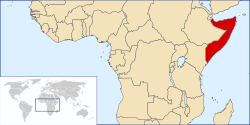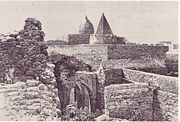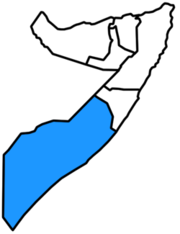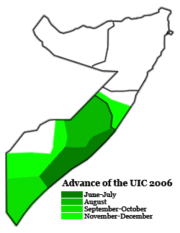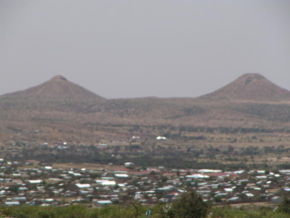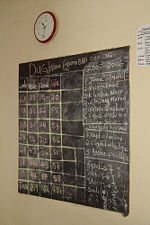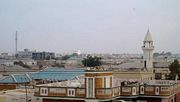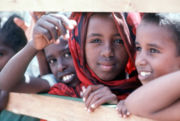Somalia
2008/9 Schools Wikipedia Selection. Related subjects: Africa; African Countries
| Soomaaliya الصومال Somalia Somali Republic
|
||||||
|---|---|---|---|---|---|---|
|
||||||
| Anthem: Soomaaliyeey Toosoow Somalia, Wake Up |
||||||
|
|
||||||
| Capital (and largest city) |
Mogadishu |
|||||
| Official languages | Somali1 | |||||
| Demonym | Somali | |||||
| Government | Transitional Federal Government | |||||
| Independence | from the UK and Italy | |||||
| - | Date | June 26 & July 1, 1960 | ||||
| Area | ||||||
| - | Total | 637,661 km² ( 42nd) 246,201 sq mi |
||||
| - | Water (%) | 1.6 | ||||
| Population | ||||||
| - | 2007 estimate | 9,118,773² ( 59th) | ||||
| - | Density | 13/km² ( 198th) 34/sq mi |
||||
| GDP ( PPP) | 2006 estimate | |||||
| - | Total | $5.26 billion ( 157th) | ||||
| - | Per capita | $600 ( 148th) | ||||
| HDI (2007) | N/A (low) ( Not Ranked) | |||||
| Currency | Somali shilling ( SOS) |
|||||
| Time zone | EAT ( UTC+3) | |||||
| - | Summer ( DST) | not observed ( UTC+3) | ||||
| Internet TLD | .so (currently non-operational) | |||||
| Calling code | +252 | |||||
| 1 | CIA Factbook | |||||
| 2 | BBC News country profile | |||||
| 3 | Transitional Federal Charter of the Somali Republic | |||||
Somalia ( Somali: Soomaaliya; Arabic: الصومال transliteration: aṣ-Ṣūmāl), officially the Somali Republic ( Somali: Jamhuuriyadda Soomaaliya, Arabic: جمهورية الصومال transliteration: Jumhūriyyat aṣ-Ṣūmāl) and formerly known as the Somali Democratic Republic, is a country located on the Horn of Africa in East Africa. It is bordered by Djibouti to the northwest, Kenya on its southwest, the Gulf of Aden with Yemen on its north, the Indian Ocean at its east, and Ethiopia to the west.
Italian Somaliland gained its independence from Italy on 1 July 1960. On the same day, it united with British Somaliland, which gained independence on 26 June 1960 to form the Somali republic. The Somali state currently exists largely in a de jure capacity; Somalia has a weak but largely recognised central government authority, the Transitional Federal Government (TFG), but this currently controls only the central region of Somalia, and before the end of 2006 controlled only the city of Baidoa.
De facto control of the north of the country resides in the local authorities; of these Puntland, Maakhir, Galmudug, acknowledge the authority of the TFG and maintain their declaration of autonomy within a federated Somalia, while Southwestern Somalia and Jubaland in the south have largely abandoned the idea of autonomy. Their political capital, Baidoa, is currently the TFG capital, and their commercial capital, Kismayo, is being disputed. On the other hand, Somaliland in the north, with its capital in Hargeisa, has declared independence and does not recognise the TFG as governing authority.
History
Continuously inhabited for the last 2,500 years by numerous and varied ethnic groups, some of Oromo or other Kushitic ancestry, and the majority Somalis. From the 1st century numerous ports including Hafun and Mosylon-Bandar Gori were trading with Roman and Greek sailors.
The northwest was part of the Aksumite Empire from about the 3rd century to the 7th but between 700 AD and 1200 AD Islam became firmly established, especially with the founding of Mogadishu in 900.
The period following, 1200 AD to 1500 AD, saw the rise of numerous Somali city-states and kingdoms. In northwestern Somalia, the Sultanate of Adal (a multi-ethnic state comprised of Afars, Somalis and Hararis) with Ahmad ibn Ibrihim al-Ghazi as their leader in 1520, successfully conquered three-quarters of Ethiopia before being defeated by a joint Ethiopian-Portuguese force at the Battle of Wayna Daga on February 21, 1543.
The Ajuuraan Sultanate flourished from the 14th to the 17th centuries. Following the collapse of Adal and Ajuuraan in the 17th century, the region saw the emergence of new city states such as the Sultanates of eastern Sanaag, of Bari, of Geledi-Afgoye, of Gasar Gudde-Lugh Ganane, of Mogadishu and the Benadir coast, and of Hobyo.
Colonial period
Competition between the Somali clans that lived in these states persisted through the colonial period, when various parts of the region were colonised by Britain and Italy. This era began in the year 1884, the end of a long period of comparative peace. At the Berlin Conference of 1884, the scramble for Africa started the long and bloody process of the imperial partition of Somali lands. The French, British, and Italians came to Somalia in the late 19th century.
The British signed treaties with the clans in what was known after as British Somaliland which was a protectorate in 1886 after the withdrawal of Egypt. Egypt sought to prevent European colonial expansion in Northeast Africa. The southern area, was colonised by Italy in 1889, became known as Italian Somaliland.
Mohammed Abdullah Hassan (Maxamed Cabdulle Xasan, Sayyid), born in the north of the Somali peninsula, was a religious, nationalist and controversial leader of. Known to the British as the "Mad Mullah", he spent 20 years leading armed resistance to the British, Italian, and Ethiopian forces in Somalia. Born into the Ogaden sub-clan of the Darod, he belonged to the Saliyah sect.
Between 1900 and 1907, the Italian leaders tried several times to negotiate a land deal with the Geledi Sultan based in ASfgoye and his Biyo-maal and Digil warriors. In 1905 more than 1,000 Biyo-maal and Tunni warriors, along with a large number of Italians, were killed when the Italian army attacked in an attempt to gain their objectives. Though many Somali warriors were killed during the war, they still defeated the enemy and succeeded in protecting the Benadir coast. After a long and bloody battle, the Italian leaders allied with other Somali tribes and their combined strength finally destroyed the Sultan's forces.
Sheikh Uways al-Barawi of the Tunni sub-clan of the Rahanweyn (Digil and Mirifle) in Barawa, lived at the same time as Hassan and led the Qadiriyyah sect. He resisted the Italian occupation in a non-violent method. He was murdered in Biyoley, in today's Bakool region, by the Dervish in 1920 as Hassan was seeking to recruit forces from Italian Somaliland. This was after the British used aircraft to destroy Hassan's base in Taleex. Sheikh Aweys rejected violence and Hassan's ways were based on violent resistance.
As a result of Hassan and his followers being chased by the followers of Sheikh al-Barawi, Hassan had to escape through the thick forest along the Jubba River until he reached Imi, Ethiopia, where he died of influenza, and, reportedly, wounds inflicted on him during his escape.
To this day the annual pilgrimage to Sheikh al-Barawi's grave in Biyoley is held where people of the Qadiriyyah sect and admirers of al-Barawi attend.
Sheikh Hassan Barsane of the Gugundhabe, a sub-clan of the Hawiye, and a member of the Ahmadi, was another Somali religious leader who resisted the Italian rule in a non-violent manner. He, like al-Barawi, rejected Hassan's approaches.
World War II
Fascist Italy, under Benito Mussolini attacked Abyssinia (now Ethiopia), with an aim to colonise it, in 1935. The invasion was condemned by the League of Nations, but little was done to stop it or to liberate occupied Ethiopia.
On August 3, 1940, Italian troops, including Somali colonial units, crossed from Ethiopia to invade British Somalia and by August 14 succeeded in taking of Berbera from the British.
A British force, including Somali troops, launched a campaign in January 1942 from Kenya to liberate British Somaliland and Italian-occupied Ethiopia and conquer Italian Somaliland. By February, most of Italian Somaliland was captured and in March, British Somaliland was retaken from the sea. The British Empire forces operating in Somaliland comprised three divisions of South African, West and East African troops. They were assisted by Somali patriot forces led by Abdulahi Hassan with Somalis of the Isaaq, Dhulbahante, and Warsangali clans.
Following the war the United Nations gave Somalia as a protectorate to Italy in 1949. The Ogaden province of Somalia was given to the re-established Ethiopian government by the British Empire, which kept British Somaliland under its protection/rule. The French also kept Djibouti under colonial administration, until eventual independence in 1977.
The State of Somalia
Though Somalis and other Africans fought hard on the Allied side in World War II, they were re-subjugated soon after the conflict. The bitterness of lost hope strengthened the long struggle against colonialism, and in most parts of Africa, including Somalia, independence movements began.
The major political parties that fought for Somalia's independence were Somali Youth Club (SYC) which later became Somali Youth League (SYL); Hizbia Digil Mirifle Somali (HDMS) which later became Hizbia Dastur Mustaqbal Somali HDMS; and the Somali National League (SNL).
The independence of the British Somaliland Protectorate from the United Kingdom was proclaimed on 26 June 1960 and unification with the former Italian Somaliland took place immediately. Now most of Somali clans were independent and the country of Somalia was formed, albeit within boundaries drawn up by Italy and Britain. A government was formed by Abdullahi Issa with Aden Abdullah Osman Daar as President, and Abdirashid Ali Shermarke as Prime Minister, later to become President ( from 1967-1969).
However inter-tribal rivalry persisted with many clans claiming to have been forced into the state of Somalia. In 1967, Muhammad Haji Ibrahim Egal became Prime Minister, appointed by Shermarke (Egal was later to become President of the breakaway independent Somaliland).
In late 1969 following the assassination of President Shermarke a military government assumed power in a coup d'état led by General Siad Barre and Chief of Police Jama Korshel. Barre became President and Korshel vice-president. The revolutionary army established large-scale public works programmes and successfully implemented an urban and rural literacy campaign, which helped dramatically increase the literacy rate from 5% to 55% by the mid-1980s.
However, struggles continued during Barre's rule. At one point he assassinated a major figure in his cabinet, Major General Gabiere, and two other officials.
It was in July 1976 when the real dictatorship of the Somali military commenced with the founding of the Somali Revolutionary Socialist Party (Xisbiga Hantiwadaagga Kacaanka Soomaaliyeed, XHKS). It was the single party that ruled Somalia until the fall of the military government in December 1990 - January 1991. It was violently overthrown by the combined armed revolt of the Somali Salvation Democratic Front (Jabhadda Diimuqraadiga Badbaadinta Soomaaliyeed, SSDF), United Somali Congress (USC), Somali National Movement (SNM), and the Somali Patriotic Movement (SPM) together with the non-violent political oppositions of the Somali Democratic Movement (SDM), the Somali Democratic Alliance (SDA) and the Somali Manifesto Group (SMG).
The Ogaden War
In 1977 and 1978 Somalia fought with its neighbour Ethiopia in the Ogaden War, in which Somalia aimed to liberate and unite the Somali lands that had been divided and subjugated under colonialism and to win the right of self-determination for ethnic Somalis in those countries. Somalia first engaged Kenya and Ethiopia diplomatically, but this failed while Somalis were being expelled from Ogaden province in Ethiopia. Somalia, already preparing for war, supported the Ogaden National Liberation Front (ONLF, then called the Western Somali Liberation Front, WSLF) and eventually sought to capture Ogaden. Somalia acted unilaterally without consulting the international community, which was generally opposed to redrawing colonial boundaries, while the Soviet Union and the Warsaw Pact countries, refused to help Somalia, and instead, backed Communist Ethiopia. For most of the war, Somalia appeared to be winning in most of Ogaden, but with Somali forces at the gates of Addis Ababa, Soviet and Cuban forces and weapons came to the aid of Ethiopia. The Somali Army was decimated and Somalia sought the help of the United States. Although the Carter Administration originally expressed interest in helping Somalia he later declined, as did American allies in the Middle East and Asia. The Americans perhaps did not want to engage the Soviets in this period of détente.
The Somali Civil War
By 1978, the moral authority of the Somali government had collapsed. Many Somalis had become disillusioned with life under military dictatorship and the regime was weakened further in the 1980s as the Cold War drew to a close and Somalia's strategic importance was diminished. The government became increasingly totalitarian, and resistance movements, encouraged by Ethiopia, sprang up across the country, eventually leading to the Somali Civil War.
1991 saw great changes in Somalia. President Barre was ousted by a combined northern and southern clan based forces all of whom were backed and armed by Ethiopia. And following a meeting of the SNM and northern clans' elders, the northern former British portion of the country declared its independence as Somaliland in May 1991; although de facto independent and relatively stable compared to the tumultuous south, it has not been recognised by any foreign government.
In January 1991, President Ali Mahdi Muhammad was selected by the anisfesto group as an interim president for the whole of Somalia until a confernece between all stakeholders to be held in Dajibuout in February of the same year to select a national leader. However, USC military leader General Mohamed Farrah Aidid, the SNMleader Abdirahman Toor and the SPMleader Col Jess refused to recognise Mahdi as president. This caused a split between the armed groups SNM,USC and SPM and the armed groups Manifesto, SDM and SNA on the one hand and within the USC forces. This led efforts to remove Barre who still claimed to be the legitimate president of Somalia from Somalia. He and his armed supporters remained in the south of the country until mid 1992 caused further escalation in violence, especially in Gedo, Bay, Bakool, Lower Shabelle, Lower Juba, Middle JUba regions. The armed conflict within the USC devastated the Mogadishu area.
The civil war disrupted agriculture and food distribution in southern Somalia. The basis of most of the conflicts was clan allegiances and competition for resources between the warring clans. James Bishop, the United States last ambassador to Somalia, explained that there is "competition for water, pasturage, and… cattle. It is a competition that used to be fought out with arrows and sabers… Now it is fought out with AK-47s." The resulting famine caused the United Nations Security Council in 1992 to authorise the limited peacekeeping operation United Nations Operation in Somalia I (UNOSOM I). UNOSOM's use of force was limited to self-defence and it was soon disregarded by the warring factions. In reaction to the continued violence and the humanitarian disaster, the United States organised a military coalition with the purpose of creating a secure environment in southern Somalia for the conduct of humanitarian operations. This coalition, ( Unified Task Force or UNITAF) entered Somalia in December 1992 on Operation Restore Hope and was successful in restoring order and alleviating the famine. In May 1993, most of the United States troops withdrew and UNITAF was replaced by the United Nations Operation in Somalia II (UNOSOM II).
However, Aidid saw UNOSOM II as a threat to his power and in June 1993 his militia attacked Pakistan Army troops, attached to UNOSOM II, (see Somalia (March 1992 to February 1996)) in Mogadishu inflicting over 80 casualties. Fighting escalated until 18 American troops and more than 1,000 Somalis were killed in a raid in Mogadishu during October 1993. The UN withdrew Operation United Shield in 3 March 1995, having suffered significant casualties, and with the rule of government still not restored.
In June 1996, Mohamed Farrah Aidid was killed in Mogadishu.
2000 – Present
Following the civil war the Majeerteen clan declared a self-governing state in the northeast, which took the name Puntland, but maintained that it would participate in any Somali reconciliation to form a new central government.
Then in 2002, Southwestern Somalia, comprising Bay, Bakool, Jubbada Dhexe (Middle Juba), Gedo, Shabeellaha Hoose (Lower Shabele) and Jubbada Hoose (Lower Juba) regions of Somalia declared itself autonomous. Although initially the instigators of this, the Rahanweyn Resistance Army, which had been established in 1995, was only in full control of Bay, Bakool and parts of Gedo and Jubbada Dhexe, they quickly established the de facto autonomy of Southwestern Somalia. Although conflict between Hasan Muhammad Nur Shatigadud and his two deputies, weakened the Rahanweyn militarily from February 2006, the Southwest became central to the TFG based in the city of Baidoa. Shatigadud became Finance Minister, his first deputy Adan Mohamed Nuur Madobe became Parliamentary Speaker and his second deputy Mohamed Ibrahim Habsade became Minister of Transport. Shatigadud also held the Chairmanship of the Rahanwein Traditional Elders' Court.
In 2004, the TFG met in Nairobi, Kenya and published a charter for the government of the nation. The TFG capital is presently in Baidoa.
Meanwhile Somalia was one of the many countries affected by the tsunami which struck the Indian Ocean coast following the 2004 Indian Ocean earthquake, destroying entire villages and killing an estimated 300 people and in 2006, Somalia was deluged by torrential rains and flooding that struck the entire Horn of Africa affecting 350,000 people.
The tribal rivalry continued in 2006 with the declaration of regional autonomy by the state of Jubaland, consisting of parts of Gedo, Jubbada Dhexe, and the whole of Jubbada Hoose. Barre Adan Shire Hiiraale, chairman of the Juba Valley Alliance, who comes from Galguduud in central Somalia is the most powerful leader there. Like Puntland this regional government did not want full statehood, but some sort of federal autonomy.
The 2006 civil war and invasion by Ethiopia
Conflict broke out again in early 2006 between an alliance of Mogadishu warlords known as the Alliance for the Restoration of Peace and Counter-Terrorism (or "ARPCT") and a militia loyal to the Islamic Courts Union (or "I.C.U."), seeking to institute Sharia law in Somalia. Social law changes, such as the forbidding of chewing khat, and even the prohibition against watching movies and football in public, were part of moves by the ICU to change behaviours and impose strict social morals.
The Union was led by Sheikh Sharif Ahmed. When asked if the ICU plans to extend its control to the rest of Somalia, Sheikh Ahmed responded in an interview:
"Land is not our priority. Our priority is the people's peace, dignity and that they could live in liberty, that they could decide their own fate. That is our priority. Our priority is not land; the people are important to us."
Several hundred people, mostly civilians caught in the crossfire, died during this conflict. Mogadishu residents described it as the worst fighting in more than a decade. The Islamic Courts Union accused the U.S. of funding the warlords through the Central Intelligence Agency and supplying them with arms in an effort to prevent the Islamic Courts Union from gaining power. The United States Department of State, while neither admitting nor denying this, said the U.S. had taken no action that violated the international arms embargo of Somalia. A few e-mails describing covert illegal operations by private military companies in breach of U.N. regulations have been reported by the UK Sunday newspaper The Observer.
By early June 2006 the Islamic Militia had control of Mogadishu, following the Second Battle of Mogadishu, and the last A.R.P.C.T. stronghold in southern Somalia, the town of Jowhar, then fell with little resistance. The remaining A.R.P.C.T. forces fled to the east or across the border into Ethiopia and the alliance effectively collapsed.
The Ethiopian-supported Transitional Government then called for intervention by a regional East African peacekeeping force. The I.C.U. meanwhile were fiercely opposed to foreign troops — particularly Ethiopians — in Somalia. claiming that Ethiopia, with its long history as an imperial power including the occupation of Ogaden, seeks to occupy Somalia, or rule it by proxy.
Meanwhile the I.C.U. and their militia took control of much of the southern half of Somalia, normally through negotiation with local clan chiefs rather than by the use of force. However the Islamic militia stayed clear of areas close to the Ethiopian border, which had become a place of refuge for many Somalis including the Transitional Government itself, headquartered in the town of Baidoa. Ethiopia said it would protect Baidoa if threatened. But on September 25, 2006, the I.C.U. moved into the southern port of Kismayo, the last remaining port held by the transitional government and issued a declaration of war against Ethiopia on October 9, 2006.
On November 1, 2006, peace talks between the Transitional Government and the ICU broke down. The international community feared an all-out civil war, with Ethiopian and rival Eritrean forces backing opposing sides in the power-struggle.
War erupted on December 21, 2006 when the leader of ICU, Sheikh Hassan Dahir Aweys said: "Somalia is in a state of war, and all Somalis should take part in this struggle against Ethiopia", and heavy fighting broke out between the Islamic militia on one side and the Somali Transitional Government allied with Ethiopian forces on the other.
In late December 2006, Ethiopia launched airstrikes against Islamic troops and strong points across Somalia. Ethiopian Information Minister Berhan Hailu stated that targets included the town of Buurhakaba, near the Transitional Government base in Baidoa. An Ethiopian jet fighter strafed Mogadishu International Airport (now Aden Adde International Airport), without apparently causing serious damage but prompting the airport to be shut down. Other Ethiopian jet fighters attacked a military airport west of Mogadishu. Ethiopian Prime Minister Meles Zenawi then announced that his country was waging war against the ICU to protect his country's sovereignty. "Ethiopian defence forces were forced to enter into war to the protect the sovereignty of the nation and to blunt repeated attacks by Islamic courts terrorists and anti-Ethiopian elements they are supporting," he said.
Days of heavy fighting followed as Ethiopian and government troops backed by tanks and jets pushed against Islamic forces between Baidoa and Mogadishu. Both sides claimed to have inflicted hundreds of casualties, but the Islamic infantry and vehicle artillery were badly beaten and forced to retreat toward Mogadishu. On 28 December 2006, the allies entered Mogadishu after Islamic fighters fled the city. Prime Minister Ali Mohammed Ghedi declared that Mogadishu had been secured, after meeting with local clan leaders to discuss the peaceful hand-over of the city. Yet as of November 2007, the Transitional Federal Government and its Ethiopian allies still face frequent attacks from an Islamic insurgency.
The Battle of Ras Kamboni
The Islamists retreated south, towards their stronghold in Kismayo, fighting rearguard actions in several towns. They abandoned Kismayo, too, without a fight, claiming that their flight was a strategic withdrawal to avoid civilian casualties, and entrenched around the small town of Ras Kamboni, at the southernmost tip of Somalia and on the border with Kenya. In early January, the Ethiopians and the Somali government attacked, resulting in the Battle of Ras Kamboni, and capturing the Islamic positions and driving the surviving fighters into the hills and forests after several days of combat. On January 9, 2007, the United States openly intervened in Somalia by sending Lockheed AC-130 gunships to attack Islamic positions in Ras Kamboni. Dozens were killed and by then the ICU were largely defeated.
As of November 30, 2007, the fighting continued in Mogadishu between transitional government Somali and Ethiopian official troops, on one hand, and Islamic militants, on the other.
Politics
Somalia has had no effective national government since 1991. The internationally recognized Transitional Federal Government, controls only parts of Southern Somalia from its base in the town of Baidoa, and is not recognized by most Somalis. On October 14, 2004, the Somali Transitional Federal Parliament elected Abdullahi Yusuf Ahmed, previously president of Puntland, to be president of Somalia. Because of the situation in Mogadishu, the election was held in a sports centre in Nairobi, Kenya. Yusuf was elected with 189 of the 275 votes from members of parliament.
Many other small political organisations exist, some clan-based, others seeking a Somalia free from clan-based politics. Many of them have come into existence since the civil war. The political situation therefore remains unstable; for example, on September 18, 2006, Abdullah Yusuf barely survived a suicide attack on his convoy in Baidoa, although twelve other people were killed.
In the northwest, there is the breakaway republic of Somaliland with its capital in Hargeisa, which declared its independence in 1991. This governing zone is not internationally recognised although it has remained more stable and certainly more peaceful than the rest of the country.
In the northeast Puntland also remains autonomous but supports the Transitional Government and unlike Somaliland considers itself still within the Somali Republic.
Sanaag Region and some parts of Bari region there is newly declared state of Maakhir which is a self-proclaimed autonomous state within Somalia on an area disputed by Somaliland and Puntland. Declared in July 1, 2007, it remains unrecognized by the Transitional Federal Government of Somalia.
Maakhir is mainly inhabited by the Warsangali clan, a member of the Harti confederation of clans (along with the Dhulbahante and Majeerteen) and a clan of the Darod tribe.
In the southwestern interior, Jubaland and Southwestern Somalia have both recognised the TFG and local leaders are part of the government.
The southern half of the country, with the bulk of the population, as of November 2007, is unstable, following the 2006 Civil War between the Transitional Government and the Islamic Courts Union.
Westerners and those working for western organisations continue to be targets of the violence. Two aid workers, one British and the other Kenyan, were abducted in Puntland on 8 May 2007 and a western nurse and her escort were shot dead in Mogadishu on 17 September 2006.
Capital
Mogadishu is the capital of Somalia. However during the conflict in 2006, Mogadishu became part of the territory controlled by the Islamic Courts Union, while the Transitional Federal Government had its seat in Baidoa. The Government returned to Mogadishu in December 2006 with the help of the invasion of Ethiopia.
Geography
Somalia is located on the east coast of Africa on and north of the Equator between the Gulf of Aden on the north and Indian Ocean on the east. Together with Ethiopia, Eritrea, and Djibouti it is often referred to as the Horn of Africa. It borders Djibouti on the northwest, Ethiopia on the west, and Kenya to the southwest. Somalia has the longest coastline in Africa.
Climate
Major climatic factors are a year-round hot climate, seasonal monsoon winds, and irregular rainfall with recurring droughts. Mean daily maximum temperatures range from 30 °C to 40 °C (85–105 °F), except at higher elevations and along the east coast. Mean daily minimums usually vary from about 15 °C to 30 °C (60–85 °F). The southwest monsoon, a sea breeze, makes the period from about May to October the mildest season at Mogadishu. The December-February period of the northeast monsoon is also relatively mild, although prevailing climatic conditions in Mogadishu are rarely pleasant. The "tangambili" periods that intervene between the two monsoons (October–November and March–May) are hot and humid.
Administrative divisions
Prior to the civil war, Somalia was divided into eighteen regions (gobollada, singular gobol), which were in turn subdivided into districts. The regions are:
|
1 Awdal |
7 Gedo |
13 Shabeellaha Dhexe |
|
On a de facto basis, northern Somalia is now divided up among the quasi-independent states of Puntland, Somaliland, Galmudug and Maakhir. The south is at least nominally controlled by the Transitional Federal Government, although resistance by Islamic groups continues in many areas. Under the de facto arrangements there are now 27 regions.
HIV/AIDS
Somalia continues to have one of the highest child mortality rates in the world, with 10% of children dying at birth and 25% of those surviving birth dying before age five. On the other hand, Somalia also has one of the lowest HIV infection rates in Africa.
The breadth of the AIDS pandemic has led to the idea in the West that the entire continent is ravaged by the disease. But Somalia — isolated for 14 years since the civil war began and populated by devout Muslims — has an infection rate of perhaps only 1.5 or 2 per cent of the adult population.
– Stephanie Nolan
Education
Education
With the collapse of the central government in 1991, the education system is now private. Primary schools have risen from 600 before the civil war to 1,172 schools today, with an increase of 28% in primary school enrolment over the last 3 years. In 2006, Puntland, an autonomous state, was the second in Somalia (after Somaliland) to introduce free primary schools with teachers now receiving their salaries from the Puntland administration. In Mogadishu, the Benadir University, the Somalia National University, and the Mogadishu University are three of the eight universities that teach Higher education in Southern Somalia. In Puntland, higher education is provided by the Puntland State University and East Africa University. In Somaliland, it is provided by Amoud University, University of Hargeisa and Burao University. Three Somali Universities are currently ranked in the top 100 of Africa. Qur'anic schools (also known as duqsis) remain the basic system of instruction for religion in Somalia. They provide Islamic education for children, thereby filling a clear religious and social role in the country. Known as the most stable, local, and non-formal education providing basic religious and moral instruction, their strength rests on community support and their use of locally made and widely available teaching materials.
The Qu'ranic system, which teaches the greatest number of students relative to the other education sub-sectors, is the only system accessible to nomadic Somalis compared to the urban Somalis who have easier access to education. In 1993, a survey by the United Nations Children's Fund (UNICEF) was conducted in which it found, among other things, that about 40% of pupils in Qu'ranic schools were girls].
Economy
Since the collapse of the state, Somalia has transformed from what Siad Barre referred to as " Scientific Socialism" to a free market economy.
Agriculture is the most important sector, with livestock accounting for about 40% of GDP and about 65% of export earnings. Nomads and semi-nomads, who are dependent upon livestock for their livelihood, make up a large portion of the population. After livestock, bananas are the principal export; sugar, sorghum, maize, and fish are products for the domestic market. The small industrial sector, based on the processing of agricultural products, accounts for 10% of GDP.
Telecommunications
Somalia's public telecommunications system has been almost completely destroyed or dismantled. However, private wireless companies thrive in most major cities and actually provide better services than in neighbouring countries. Wireless service and Internet cafés are provided. Somalia was the last African country to access the Internet in August 2000, with only 57 web sites known as of 2003. Internet usage in Somalia grew 44,900% from 2000 to 2007, registering the highest growth rate in Africa. Somalia has the cheapest cellular calling rates in Africa, with some companies charging less than a cent a minute. Competing phone companies have agreed on interconnection standards, which were brokered by the United Nations funded Somali Telecom Association.
Companies providing telecommunication services are:
|
|
|
Environment
Somalia is a semi-arid country with about 2% arable land. The civil war had a huge impact on the country’s tropical forests by facilitating the production of charcoal with ever present, recurring, but damaging droughts. Somali environmentalist and Goldman Environmental Prize winner, Fatima Jibrell, became the first Somali to step in and do a much-needed effort to save the rest of the environment through local initiatives that organised local communities to protect the rural and coastal habitat. Jibrell trained a team of young people to organise awareness campaigns about the irreversible damage of unrestricted charcoal production. Jibrell also joined the Buran rural institute that formed and organised the Camel Caravan program in which young people loaded tents and equipment on camels to walk for three weeks through a nomadic locale and educate the people about the careful use of fragile resources, health care, livestock management and peace.
She has consistently fought against the burning of charcoal, logging and other man-induced environmental degradation. Her efforts have born fruits to the local communities across Somalia and international recognition when she won the prestigious Environmental Goldman award from San Francisco. Jibrell is also the executive director of Horn Relief and Development Organisation.
Demographics
Somalia has a population of around 10,700,000 according to U.N. estimates in 2003, 85% of which constitute ethnic Somalis.
There is little reliable statistical information on urbanisation in Somalia. However, rough estimates have been made indicating an urbanisation of 5% and 8% per annum with many towns rapidly growing into cities. Currently, 34% of the Somali population lives in towns and cities with the percentage rapidly increasing.
Because of the civil war, the country has a large diaspora community, one of the largest of the whole continent. There are over a million Somalis outside of Africa, and this excludes those who have inhabited the Ogaden province, northeastern Kenya, and Djibouti.
Languages
Somali is the main language and is used virtually everywhere and nearly every Somali citizen speaks it. Minority languages do exist, such as Af-Maay, which is spoken in areas in South-Central Somalia by the Rahanweyn tribes and Jareer, as well as variants of Swahili ( Barawe), which are spoken along the coast by Arabs. Mashungulis are part of the Somali Bantu (Jareer) people and speak Zigua and Swahili
A considerable number of Somalis speak Arabic due to religious reasons and ties with the Arab World and media. English is also widely used and taught, Italian used to be a major language but due to the civil war and lack of education only the older generation still uses it.
Religion
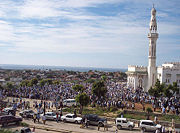
The Somalis are almost entirely Sunni Muslims. Christianity's influence was significantly reduced in the 1970s when church-run schools were closed and missionaries sent home. There has been no Archbishop of the Catholic cathedral in the country since 1989; the cathedral in Mogadishu was severely damaged in the civil war of January-February 1992. The Somali constitution discourages the promotion and propagation of any religion other than Islam. This sets Somalis apart from their immediate African neighbours, many of whom are either Christians (particularly the Amhara people and others of Ethiopia and Kenya) or adherents of indigenous African faiths.


